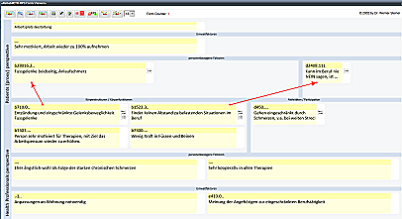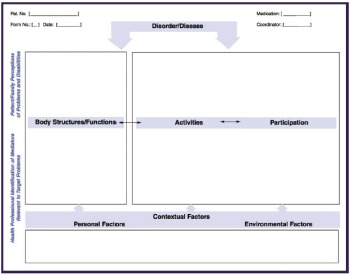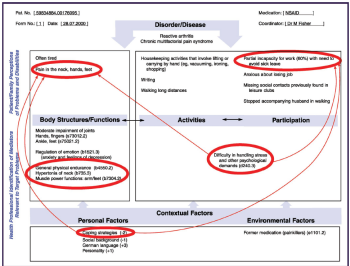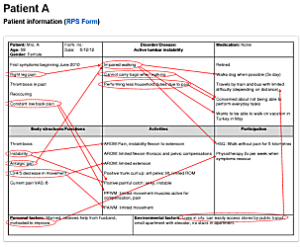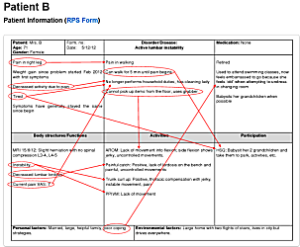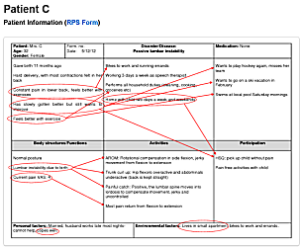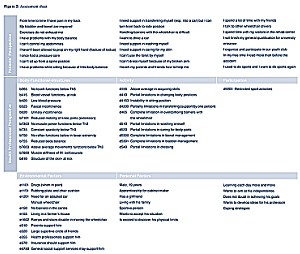
 Zurück
Zurück
 Print
Print
| Home | | | Dienstleistungen | | | | | Kundenplattform | | | Wissenswertes | | | Kontakt+Support |
| AGB | / | Downloads | / | RPS-Form weltweit | / | RPS-Form Video |
«RehabNET RPS-Form», weltweite Nutzung
Anwendung RPS-Form (ICF-Blatt) gemäss Original-Publikation:
"Use of the ICF model as a clinical problem-solving tool in physical therapy and rehabilitation medicine."
Steiner WA, Ryser L, Huber E, Uebelhart D, Aeschlimann A, Stucki G.: Use of the ICF model as a clinical problem-solving tool in physical therapy and rehabilitation medicine. Phys Ther. 2002 Nov; 82(11):1098-107.
Download Publikation
![]()
«RehabNET RPS-Form»: Version mit integriertem"Clinical Reasoning"
Darstellung Fall-ManagementRehabNET hat das «RehabNET RPS-Form» webbasiert entwickelt mit der interessanten Möglichkeit, "klinisches Reasoning" zu visualisieren. Jeder Pfeil ("Connecting Line") zwischen zwei Kategorien ist mit einem Textfeld hinterlegt, welches die Begründung zur gedachten Abhängigkeit enthält. Das Modul hatte ferner einen aktualisierten ICF-Browser integriert, sowie einen «ICF-Core-Set Manager», der das Anlegen eigener "ICF-Short Lists" erlaubte. Das Interesse an ICF-basiertem Patienten-Management blieb jedoch insgesamt recht bescheiden, so dass RehabNET die Entwicklung der Web-Applikation «RehabNET RPS-Form» auf Ende 2020 eingestellt hat.. |
«RehabNET RPS-Form» (erweiterte RPS-Version, Originalversion siehe Steiner et. al 2002) Grössere Ansicht: Auf Bild klicken! |
| top |
Original-Darstellung "RPS-Form 2002":Steiner WA, Ryser L, Huber E, Uebelhart D, Aeschlimann A, Stucki G.: Use of the ICF model as a clinical problem-solving tool in physical therapy and rehabilitation medicine. Phys Ther. 2002 Nov; 82(11):1098-107. Figur 2: Papierversion RPS-Form (auch ICF-Blatt genannt). Zu beachten: "Personal Factors" und "Environmental Factors" können nur im unteren Bereich des RPS-Forms dokumentiert werden. Damit konnte die Perspektive der Patienten nicht genügend dargestellt werden. Aus diesem Grunde wurde das "RPS-Form 2002" stark verbessert für die spätere Online Version. |
Grössere Ansicht von Figur 2: Auf Bild klicken! |
|
|
Figure 2. (Original-Beschreibung): "The Rehabilitation Problem-Solving Form (RPS-Form) is based on the International Classification of Functioning, Disability, and Health (ICF) Model of Functioning and Disability15 (see Fig. 3). The main difference is that the RPS-Form is divided into 3 parts: (1) header for basic information, (2) upper part to describe the patient's perspective, and (3) lower part for the analysis of the health care professionals. Copyright 2000 by Dr Werner Steiner, Switzerland. Reprint allowed with permission only." |
||
Fall-Beispiel, Original RPS-Form 2002:
Figure 4. (Original-Beschreibung): Copyright 2000 by Dr Werner Steiner, Switzerland. Reprint allowed with permission only." |
Grössere Ansicht von Figur 4: Auf Bild klicken! |
|
| top |
«RehabNET RPS-Form», Publikationen und Web-Seiten
1) RPS-Form für Case-ManagementLumbar Spine AssessmentFallbeispiele folgender Autorinnen: Masiero, Philippart, Vanderzwaag Hogeschool van Amsterdam; European School of Physiotherapy (ESP) Quelle: https://lumbarspineassessment.wordpress.com/about/ |
Grössere Ansicht: Auf Bild klicken! |
|
|
Grössere Ansicht: Auf Bild klicken! |
Grössere Ansicht: Auf Bild klicken! |
|
| top |
Das RPS-Form (Steiner et al. 2002) als Grundlage für das "ICF Assessment Sheet"
Das RPS-Form findet zunehmend auch in der Schweiz Verwendung im Management komplexer Patienten-Situationen. Die ICF Research Branch (ICF Research Branch) zeigt die Verwendung von ICF-Tools im modernen Patienten-Management. Dabei wird das rechts abgebildete «ICF Assessment Sheet» verwendet, welches inhaltlich anlehnt an das «WHO-Modell der Funktionsfähigkeit und Behinderung» sowie an das RPS-Form (Steiner et al. 2002) mit der typischen Aufspaltung in "Health Professional Perspective" [unten] und in die "Patients' Perspective" [oben].
Zitat: ICF Assessment Sheet: "To describe the patient’s experience of functioning, his or her own words are used to fill in the patient’s perspective. To reflect the health professional’s perspective, all results from the clinical assessment relevant to the description of the patient's functioning status at the time of assessment are entered in the lower part of the sheet, ideally using ICF categories. In order to use the common language of the ICF, the original technical terminology of the clinical assessment has to be translated or ‘linked’ to the corresponding ICF categories. Established linking rules can greatly facilitate this process. Environmental factors can also be indicated using ICF categories. " |
ICF Assessment Sheet
Swiss Paraplegic Research © https://www.icf-research-branch.org/ |
| top |
ICF LiteraturDas RPS-Form (Steiner et al. 2002) wurde weltweit zitiert/verwendet(Ausgewählte Publikationen, neuste oben):
|
| top |
| «Homepage RehabNET»: Ohne Cookies = Keine lästigen Meldungen, 100% Datenschutz ! | ||||||
 Sitemap Sitemap
|
 Home Home
|
© RehabNET AG | ||||
